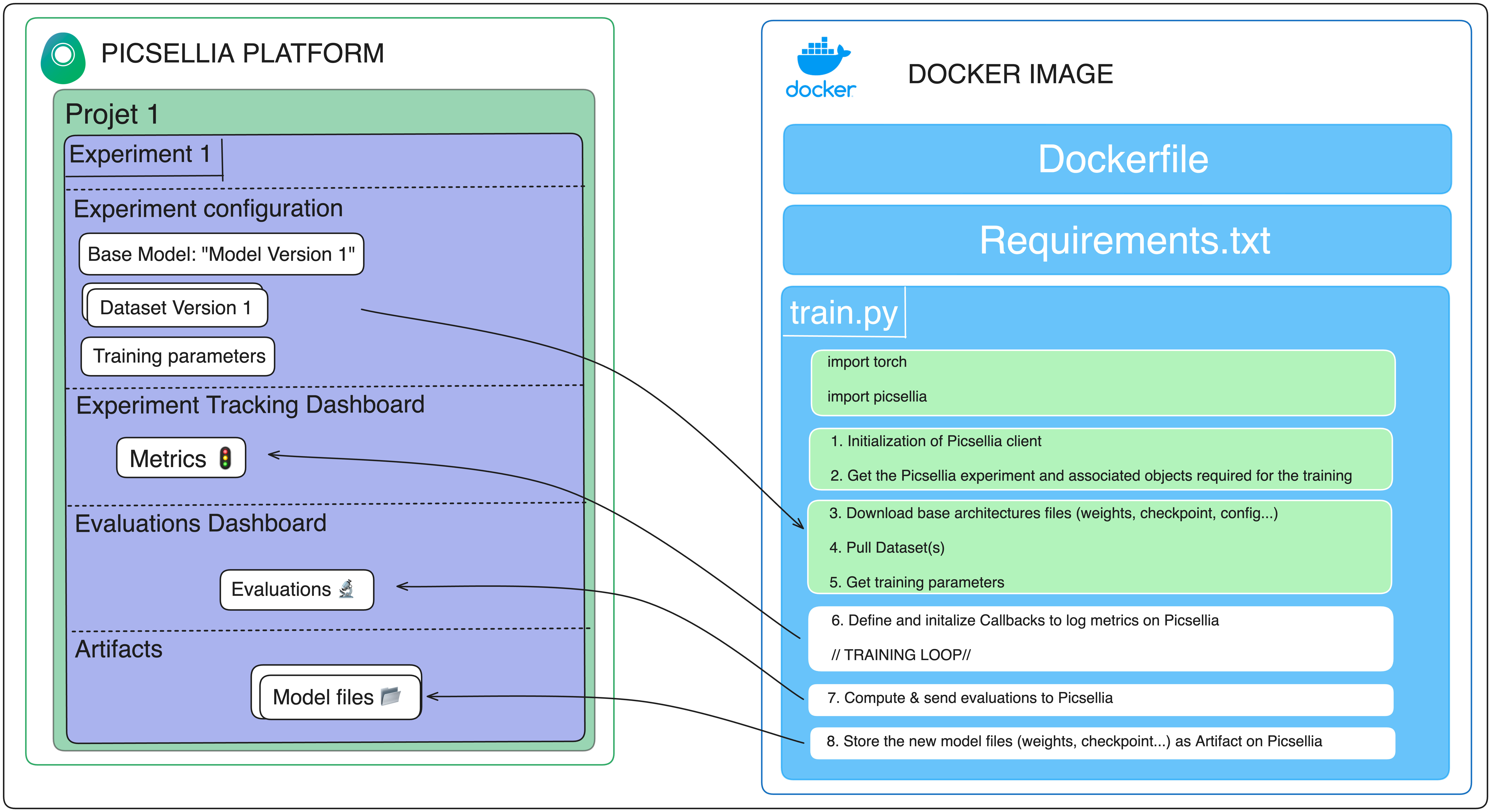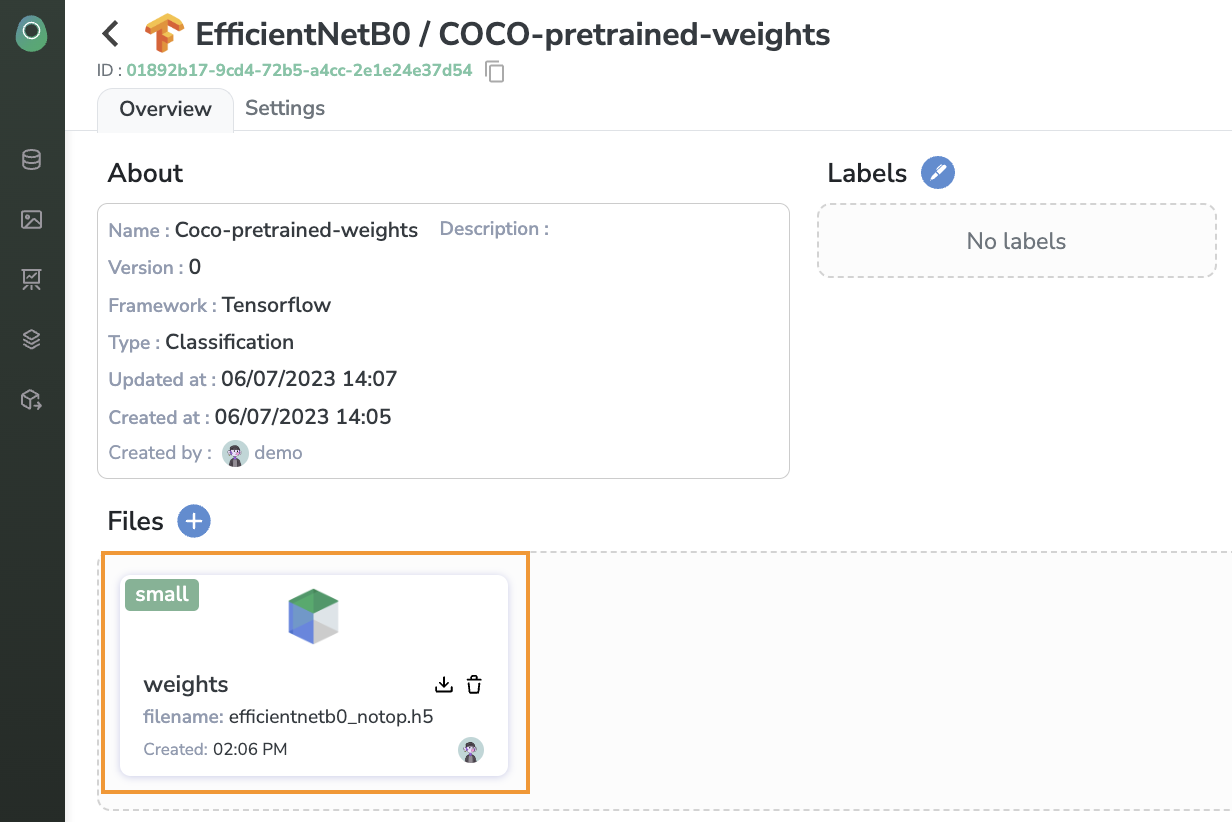3. Retrieve Data, files and parameters from Picsellia
It is now time to dissect your code and understand which object needs to be pulled from the Picsellia platform.
As a reminder, let's take another look at our schema:

The objects that you will now download from Picsellia include:
- The relevant
DatasetVerison, which consist ofAsset(check Datasetversion). - The relevant weights files, including checkpoints, configuration files, and more (check Modelfile).
- The training parameters, such as the number of epochs and image size (check parameters).
1. Downloading the DatasetVersion
DatasetVersionAs we are doing a CLASSIFICATION use-case, we are going to download our DatasetVersion train and test in a folder structure way like this:
.
├── train/
│ ├── label_name_1/
│ │ ├── img1.jpg
│ │ ├── img2.jpg
│ │ └── ...
│ ├── label_name_2/
│ │ ├── img4.jpg
│ │ └── ...
│ └── ...
└── test/
├── label_name_1/
│ └── ...jpg
└── label_name_2/
└── ...jpgYou can use the SDK to retrieve the DatasetVersion like this:
import os
client = Client(
api_token="XXXX",
organization_name="XXXX",
host="https://app.picsellia.com"
)
project = client.get_project("documentation-project")
experiment = project.get_experiment("exp-0-documentation")
datasets = experiment.list_attached_dataset_versions()
for dataset in datasets:
for label in dataset.list_labels():
os.makedirs(os.path.join(dataset.version, label.name))
assets = dataset.list_assets(
q=f"annotations.classifications.label.name = \"{str(label.name)}\""
).download(os.path.join(dataset.version, label.name))If you want to understand more about Picsellia Asset and Export Annotations Fileoptions you can check our Client reference (for example, you can download your dataset in COCO or YOLO format).
2. Downloading the weights
For our custom EfficientNetB0 model, we stored our weights under the name weights.

So let's download them!
# ...
base_model = experiment.get_base_model_version()
base_model_weights = base_model.get_file('weights')
base_model_weights.download()3. Retrieving the training parameters
Our training script is taking some parameters as inputs, allowing the user to customize the training. So we need to retrieve the parameters defined in the Picsellia Experiment and pass them to the training script.
# ...
parameters = experiment.get_log(name='parameters').data
IMG_SIZE = parameters['image_size']
batch_size = parameters['batch_size']Parameters are sent by Picsellia as a dictionary, for instance:
parameters = {
'epochs': 50,
'batch_size': 64,
'image_size': 224
} So now you just need to assign each parameter to its related variable in your training script!
4. Wrapping up
Now your training script should look something like this.
from tensorflow.keras.applications import EfficientNetB0
from tensorflow.keras.models import Sequential
from tensorflow.keras import layers
import tensorflow as tf
import tensorflow_datasets as tfds
from picsellia import Client
import os
## Initialization of the Picsellia client
client = Client(
api_token="XXXXXXX",
organization_name="my_organization",
host="https://app.picsellia.com"
)
## Retrieve the Picsellia experiment that needs to be trained
project = client.get_project("documentation_project")
experiment = project.get_experiment("exp-0-documentation")
## Download the datasets from Picsellia and organize the data on the infrastrcture drive
datasets = experiment.list_attached_dataset_versions()
for dataset in datasets:
for label in dataset.list_labels():
os.makedirs(os.path.join(dataset.version, label.name))
assets = dataset.list_assets(q=f"annotations.classifications.label.name = \"{str(label.name)}\"").download(os.path.join(dataset.name, label.name))
## Get base model of this experiment and download associated files
base_model = experiment.get_base_model_version()
base_model_weights = base_model.get_file('weights')
base_model_weights.download()
## Get experiment parameters that will define the training
parameters = experiment.get_log(name='parameters').data
IMG_SIZE = parameters['image_size']
batch_size = parameters['batch_size']
## Hardware connection
try:
tpu = tf.distribute.cluster_resolver.TPUClusterResolver.connect()
print("Device:", tpu.master())
strategy = tf.distribute.TPUStrategy(tpu)
except ValueError:
print("Not connected to a TPU runtime. Using CPU/GPU strategy")
strategy = tf.distribute.MirroredStrategy()
## Keras preprocessing
size = (IMG_SIZE, IMG_SIZE)
train_img_gen = tf.keras.preprocessing.image.ImageDataGenerator(rescale=1./255, rotation_range=20)
test_img_gen = tf.keras.preprocessing.image.ImageDataGenerator(rescale=1./255)
ds_train = next(train_img_gen.flow_from_directory('train', target_size=size))
ds_test = next(test_img_gen.flow_from_directory('test', target_size=size))
NUM_CLASSES = len(experiment.get_dataset('train').list_labels())Updated 6 months ago